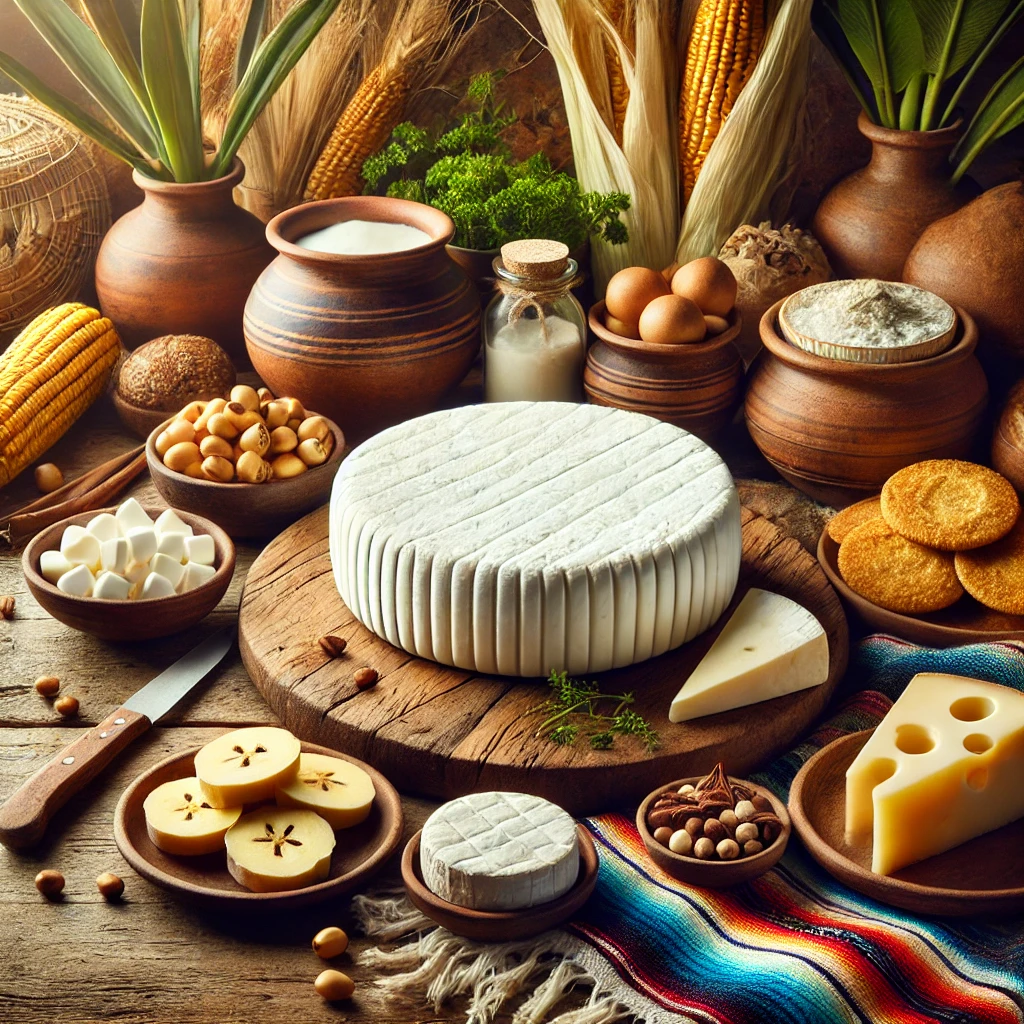Colombia’s culinary landscape stretches from Andean mountains to Amazonian plains, and within this vast geography lives one of the country’s most comforting dairy staples: queso cuajada. Soft, clean-tasting, fresh, and gently acidic, queso cuajada is the cheese that finds its way into breakfasts, farm kitchens, street markets, and the heart of Colombian dairy culture.
Unlike aged cheeses that rely on months of maturation, cuajada champions fresh milk, artisanal hands, and rural simplicity. It is cheese at its most honest—no rind, no brine barrels, no heavy salt—just fresh curd shaped by Colombia’s long dairy tradition.
🧀 What Is Queso Cuajada?
Queso cuajada is a fresh, soft, unsalted (or lightly salted) Colombian cheese made from cow’s milk. Its name comes from cuajar—to curdle or set milk.
Key Characteristics
| Feature | Description |
|---|---|
| Texture | soft, moist, delicate curd |
| Flavor | fresh milk sweetness, light tang |
| Salt | minimal to none |
| Color | bright white |
| Aroma | clean, dairy-pure |
| Fat Content | moderate, depends on milk |
| Aging | none; consumed fresh |
Cuajada is Colombia’s answer to light, rustic, farm-made cheese, beloved in both home kitchens and countryside haciendas.
🇨🇴 Origins in Colombian Dairy Culture
Queso cuajada has deep roots in Colombian highland farming communities, especially:
-
Boyacá
-
Cundinamarca
-
Antioquia
-
Santander
Pasture-fed cattle, fresh morning milkings, and small curdling vats have shaped cuajada’s unmistakable farmhouse identity.
Why It Endures
-
quick production with raw or pasteurized milk
-
perfect for warm climate consumption
-
neutral flavor loved by all generations
-
fits seamlessly within Colombian breakfast culture
Colombia’s dairy lineage is influenced not by European aging practices but by immediacy and proximity to the farm.
🥛 How Queso Cuajada Is Made
Though industrial versions exist, true cuajada is still made traditionally in countryside homes and local dairies.
Traditional Method
-
Fresh Milk Heating
Morning milk is gently warmed. -
Curdling Agent Added
Rennet (cuajo) or natural souring separates curd from whey. -
Cutting the Curd
Soft curd is gently sliced to release whey. -
Draining
Whey is strained through cloth or baskets. -
Molding
Curds settle into soft, pillow-like fresh cheese.
What Makes It Unique
-
no pressing until dry
-
no brining
-
no heavy salting
-
no fermentation beyond the basic set
What remains is pure milk in its softest edible form.
🍽 How Colombians Eat Queso Cuajada
Cuajada pairs beautifully with sweet and salty elements alike, embodying Colombian flavor balance.
Classic Pairing: Cuajada con Melao
-
fresh cuajada
-
melao (panela syrup)
This beloved duo combines dairy sweetness with caramel depth of cane sugar.
Everyday Breakfast Uses
| Dish | Role of Cuajada |
|---|---|
| Arepas | crumbled or sliced filling |
| Envuelto de maíz | mild dairy counterpoint |
| Chocolate santafereño | creamy bite between sips |
| Buñuelos & almojábanas | soft cheese plate pairing |
Cuajada works best when eaten simple and fresh, highlighting milk purity.
🌶 Flavor & Texture Profile
Flavor Notes
-
fresh milk
-
mild yoghurt tang
-
gentle creaminess
Texture Notes
-
soft without melting
-
moist, spoonable when very fresh
-
slightly firmer after draining
It avoids the saltiness of queso costeño and the firmness of queso campesino.
🌍 How Queso Cuajada Compares with Other Latin Cheeses
| Cheese | Similarity | Difference |
|---|---|---|
| Queso Fresco (Mexico) | fresh curd base | cuajada is softer & less salted |
| Queso Blanco (Venezuela) | white & mild | cuajada is moister |
| Cuajada (Spain) | curdled milk | Colombian version is cheese-set, not dessert-style |
| Requesón | soft and creamy | cuajada is curd-formed, not spreadable |
Cuajada lives in a category of its own: fresh, dairy-honest, Colombian to the bone.
🍷 Pairing & Serving Suggestions
Although dairy is rarely paired with alcohol in Colombian tradition, cuajada works well with fresh beverages.
Traditional Pairings
-
aguapanela (panela drink)
-
hot chocolate
-
café tinto
-
guayaba juice
Modern Pairings
| Beverage | Why It Works |
|---|---|
| light lager | contrast without overpowering |
| sparkling water | refreshes between bites |
| cold brew coffee | silky balance |
🌱 Nutrition Highlights
Per 100g (approx.):
| Nutrient | Value |
|---|---|
| Calories | moderate |
| Protein | decent natural source |
| Fat | balanced, fresh milk level |
| Sodium | very low |
| Calcium | strong presence |
Why It’s Seen as Healthy
-
low salt
-
low processing
-
fresh milk content
-
easy digestion
🧀 Why Queso Cuajada Matters
Cuajada reflects rural pride and dairy authenticity:
-
produced by small farmers
-
sold in morning markets
-
eaten with panela, arepas, and fruit
It is not just cheese—it is regional identity wrapped in simplicity.
In a fast-paced world of industrial foods, cuajada remains:
-
unpackaged
-
unstressed
-
unaltered
Just milk, curd, and Colombian countryside character.
⭐ Final Summary
Queso cuajada is Colombia’s love letter to dairy purity:
-
soft curd texture
-
light tang
-
barely salted flavour
-
fresh-morning production
It thrives because it feels like home—breakfast tables, family spreads, milk farms, and quiet rural kitchens. In every bite, it carries the essence of Colombian land and agricultural rhythm.
FAQs — Queso Cuajada
1. Is queso cuajada salty?
No—typically unsalted or very lightly salted.
2. What milk is used?
Mostly cow’s milk, sometimes mixed with small-farm variations.
3. How is it eaten in Colombia?
With panela syrup, arepas, hot chocolate, fruit, and bread.
4. Does cuajada melt?
It softens but does not melt or stretch.
5. Is queso cuajada aged?
No, it is eaten fresh within 1–3 days of preparation.



